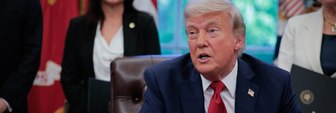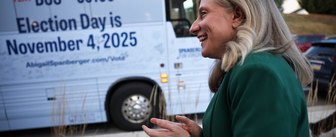Hello, I'm Will Jordan and welcome to The Pulse.
Tightening polls, convention bounces, and some skepticism about third party polling. Here's what you need to know:
- Where do things stand?
This is a useful place to start, before getting into the Republican National Convention. Our last update was published soon after Hillary Clinton had been publicly castigated by the FBI director over her emails, but before much polling had been released. Then on Wednesday there was an avalanche of new national and swing state polls, which, taken together, suggested a tightening of the national race from about a 5- or 6-point Clinton lead to something more like 3 or 4. Less polling has been done since Mike Pence was announced as Donald Trump's running mate, but a YouGov/Economist Poll taken over the weekend suggests little impact (Trump still 3 points down). - Wait, but I heard –
As is common, polls that suggested a bigger shift in the race – including Quinnipiac polls showing Clinton trailing in Florida and Pennsylvania and a national CBS/NYT poll showing a tie – got the most attention. YouGov’s own swing state polling shows a roughly tied race. But even results like these make sense given variation you would naturally see if Clinton were actually a few points ahead, something Nate Cohn helpfully illustrates by “simulating” 100 surveys if Clinton were really 4 points ahead. In the simulation, about 1 in 20 polls show a tied race, and 1 in 20 show Clinton 8 points up. Either way, if history is a guide, Trump probably will be doing a bit better in polls by the end of the week. - Why is that?
The convention bounce, obviously. There are lots of election myths out there, but the convention bounce – a candidate rises in polls after their party’s convention – has good supporting evidence. As outlined by political scientist John Sides, the bounce is real and can be spectacular (in 1992, Bill Clinton saw his support grow by 14 points). However, as Thomas Holbrook notes, the effect has been smaller in recent years. He argues this may be because recent conventions were held in consecutive weeks, effectively canceling each other out, or because they have taken place later in the summer, meaning some of the partisan voters who usually rally to their party’s nominee during the convention may have already done so. On top of that, the electorate is as polarized as ever, leaving fewer voters willing to be nudged either way by convention fanfare. - What does that mean for this year?
There are mixed signals. This year’s conventions are on consecutive weeks, but they also take place earlier in the summer, and, as we discussed last week, an unusually large number of voters have yet to rally to one of the major party nominees. So far, the GOP convention has been a bit chaotic. Officials had to squelch an anti-Trump revolt, some of the party’s biggest stars are sitting the event out, and – whatever you think about plagiarism – media coverage has probably focused less on “humanizing Trump” than the campaign hoped. For me, the big question is whether Trump can break out of the high-30s/low-40s level where he’s been stuck all year. To win with those numbers, he would need third-party candidates to do tremendously well, preventing Clinton from reaching back into the mid-/high-40s, where her support was only a few months ago. - Don’t some polls show Johnson – and Stein – doing pretty well?
Yes, they do. The CBS/NYT poll mentioned earlier showed Libertarian Gary Johnson with 12% support. Who’s to say he couldn’t rise a few more points to pass the 15% threshold required to participate in the debates and – with the help of Jill Stein, now at 4% – make it possible for Trump to win with only 41%? Crazier things have happened. Did you know Donald Trump is the GOP nominee? But I’m not convinced yet. I don’t even believe Johnson has solid support near 10%, let alone 15%. To get a bit into the weeds, one reason I believe this is a gap that’s opened up between online polls and live interview (phone) polls that ask a “four-way” question, mentioning Trump, Clinton, Johnson and Stein.
Johnson and Stein both get twice the support in phone polls than online polls during this period, with almost all difference going to “none of the above”. Rather than how the interview is conducted – online or by phone – the key here seems to be that online polls usually list the “undecided” or “no preference” options. Over the phone, thes responses have to be volunteered, possibly leading less firmly decided voters to lend support to one of the listed candidates. In line with this thinking, one online pollster that doesn’t list the undecided options, NBC/SurveyMonkey, just released a poll, and it shows Johnson and Stein getting bigger numbers (10% and 5%).
The evidence suggests support for third party candidates may be softer than it looks. After the conventions we should have a better idea just how soft.
Extra reading:
- The Upshot at the New York Times estimates Hillary Cilnton has a 76% probability of winning the presidency, based on each state's voting history and recent polling.
- Nate Silver can't find much evidence Donald Trump benefits from a "world in chaos".
- The Washington Post examines why Trump has significant support among voters who believe he is not qualified for the presidency.
- Pew Research has some great visuals detailing Donald Trump's winding path to the nomination. Most GOP voters changed their mind at least once betwee April and December.
The Pulse is a weekly newsletter YouGov has launched ahead of the 2016 primaries and general election to give readers a one-stop-shop for the latest polling-related news from the campaign. In addition to YouGov’s own extensive coverage of the election, The Pulse gives you the five things you need to know about the state of the campaign each week.









